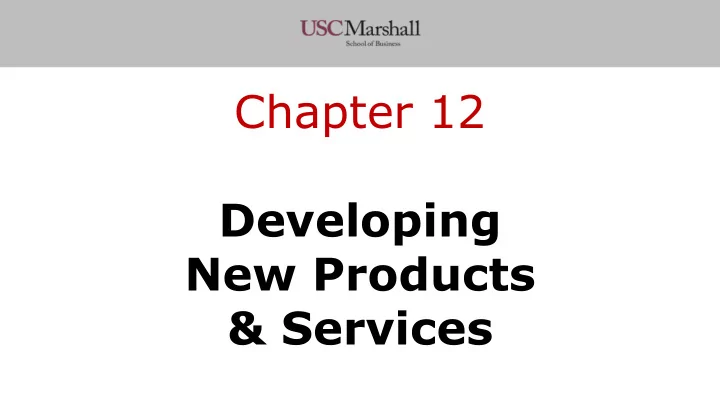

Chapter 12 Developing New Products & Services
Today Identify the reasons firms create new products. • Describe the different groups of adopters. • Describe the various stages involved in developing a new product or service. • Explain the product life cycle. • 2
Innovations Innovation à process by which ideas are transformed into new offerings Without innovation firms have two options 1. Continue to market current products to current customers 2. Take the same product to a new market 3
Why Firms Need to Innovate? Healthier and greener consumers Everyone that wanted to Walmart asks suppliers for product got it so no info about all their more growth products Products that rely on fashion Multiple products can better trends (apparel, arts, books, withstand shocks like changes videogames) have a short life in consumer preferences cycle Creating or maintaining a sustainable competitive advantage!!! 4
New Product Introductions Pioneers radically change competition and consumer preferences by introducing new-to-the-world products 5
New Product Introductions Pioneers radically change competition and consumer preferences by introducing new-to-the-world products – Have first mover advantage à readily recognizable by consumers – But many fail! • Google Glass • Apple Newton • New Coke • … 6
Diffusion of innovation 7
Diffusion of innovation Those that stand in line for a new product. Spread positive word of mouth. 8
Diffusion of innovation Wait for a review, less risk. Spread positive word of mouth. Those that stand in line for a new product. Spread positive word of mouth. 9
Diffusion of innovation Wait for a Vital for profits. review, less Avoid risks by risk. Spread waiting. positive word of mouth. Those that stand in line for a new product. Spread positive word of mouth. 10
Diffusion of innovation Product reached full Wait for a market potential. Vital for profits. review, less Sales level off or start Avoid risks by risk. Spread to decline waiting. positive word of mouth. Those that stand in line for a new product. Spread positive word of mouth. 11
Diffusion of innovation Product reached full Wait for a market potential. Vital for profits. review, less Sales level off or start Avoid risks by risk. Spread to decline waiting. positive word of mouth. They don’t like changes and avoid them. Those that stand in line for a new product. Spread positive word of mouth. 12
How Firms Develop New Products In very general terms, these are the stages of new-product (or service) development: But even if you have a great idea, the new-product development process can become somewhat messy, costly, and aimless in the absence of a very clearly-articulated (and well-executed) new product development methodology! 13
Failure is (almost) inevitable! Microsoft didn't create Internet Explorer to be a way of downloading Google Chrome but… https://www.reddit.com/r/dataisbeautiful/comments/cxu ah9/usage_share_of_internet_browsers_1996_2019_oc/ 14
1. Idea Generation Internal R&D Customer R&D input consortia Source of ideas Competitor’ Licensing products Outsourcing Brainstorming 15
Internal R&D • High product development costs • Often the source of technological products or breakthrough products 16
R&D Consortia • Firms join together to form research consortiums • Lower costs and risks • Benefits spread to all firms • Example: pharmaceutical industry research 17
Licensing • Firms purchase the rights to technology or ideas from other research-intensive firms • University research centers also often provide such licenses 18
Brainstorming • Groups work together to generate ideas • No idea can be immediately dismissed 19
Outsourcing Leverage outside firms to generate new ideas 20
Competitors’ Products • Reverse engineering • Copycat products Products with patents or other proprietary protections cannot be copied, so reverse engineered products must be substantively different from their source product. 21
Customer Input 22
2. Concept testing • Concept is a brief written description of the product • Customers reactions determine whether or not it goes forward • Triggers the marketing research process 23
3 .Product Development Prototype is created – Alpha testing • Within the firm – Beta testing • Uses potential customers Tesla To Skip Beta Development Phase And Start Building “Early- Release” Model 3s This Week: http://www.carscoops.com/2017/03/tesla-to- skip-beta-development-phase.html 24
4. Market Testing • Premarket tests • Test marketing (only for a (product not in the limited geo area) market yet) – Mini product launch – Customers exposed – More expensive than premarket – Customer surveyed – Market demand estimated – Sales estimated – Firm makes decision 25
5. Product launch Part art and part science – Tech companies use events • Apple • Google • Airbnb – Tesla did too! Convey characteristics and KEY BENEFITS (which will convince buyers!) 26
6. Evaluation of Results • Satisfaction of technical requirements • Customer acceptance • Satisfaction of the firm’s financial requirements 27
Product life cycle 28
Product life cycle Introduction Introduction Growth Growth Maturity Maturity Decline Decline Sales Sales Low Low Rising Rising Peak Peak Declining Declining Negative or Negative or Peak to Peak to Profits Profits Rapidly rising Rapidly rising Declining Declining low low declining declining Early Early adopters and adopters and Typical Typical Innovators Innovators Late majority Late majority Laggards Laggards consumers consumers early early majority majority High number High number of of Competitors Competitors Low number Low number (number of (number of Few but Few but competitors competitors of of One or few One or few increasing increasing firms and firms and and and competitors competitors competitive competitive products) products) and products and products products products 29
Recommend
More recommend